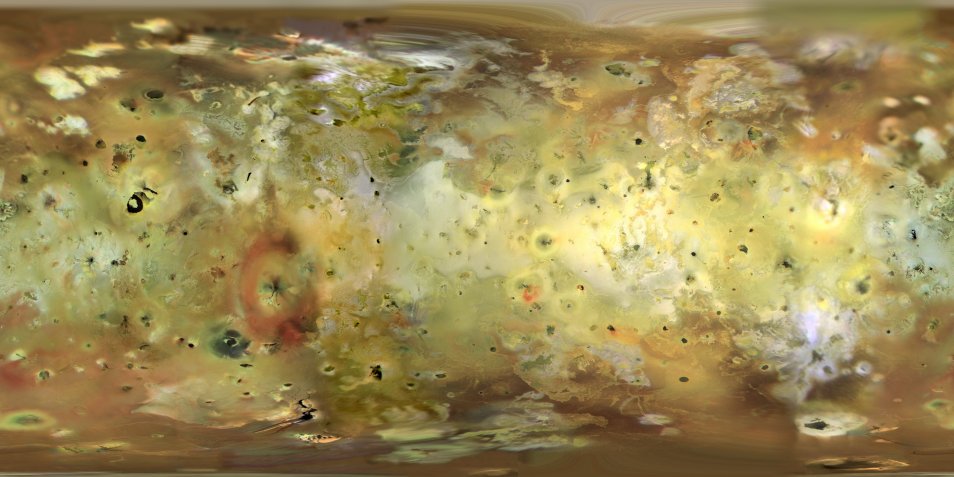
"We would love to be able to place seismometers on Io and measure the quakes to determine the interior but we just don't have that available to us at the moment. This time they've used the technique to study a hot volcanic world."Īccording to Brown studying the interaction between a moon and the host planet's magnetic field is the best available way of determining that moon's internal composition. The big difference is they're all relatively cold, icy moons. Io is named after a maiden who was loved by Zeus. It is just slightly larger than Earths moon. "That's something which has been done previously with the Jovian moons Europa, Ganymede and Callisto. The Maiden Io, eye-oh or eey-oh, is the fifth of Jupiters moons and the third largest. "By showing how Io deflects Jupiter's magnetic field, Khurana and colleagues are inferring new data about this moon's internal structure," says Brown. Moons of Jupiter A montage of Jupiter and its four largest moons (distance and sizes not to scale) There are 95 moons of Jupiter with confirmed orbits as of 23 March 2023. A different way of doing scienceĭr Michael Brown, an astronomer at Melbourne's Monash University, says the research is intriguing. This is surrounded by a thick mantle most likely composed of the igneous minerals peridotite and forstenite, both containing magnesium and olivine. They conclude Io's mantle is too hot to effectively cool its core, which has remained molten and explains why the moon doesn't generate a powerful magnetic field.Ĭombined with previous gravity studies, Khurana and colleagues paint a picture of Io having a molten metallic iron core with a radius of up to 950 kilometres. Surface lava temperatures hint at an upper mantle temperature of up to 1450☌. The researchers say the global, subsurface magma layer of the mantle must be over 50 kilometres thick and is kept partially molten by tidal forces. They also assumed Io's overall composition started out similar to chondritic meteorites, before separating into geological layers during its formation. Khurana and colleagues modelled the mantle's electrical properties on examples found in the Earth's upper mantle. Reporting in the journal Science, the researchers claim magnetometer data collected by Galileo, found Io's inductive response suggests a vast, electrically conductive reservoir of magma beneath the crust. In the absence of seismometers and other direct sensing devices, they used Jupiter's magnetic field as a sounding signal. Now a re-analysis of magnetic field data from NASA's Galileo spacecraft by Dr Krishan Khurana from the University of California, Los Angeles and colleagues has provided evidence of a huge magma ocean inside Io. The extent of this melting has been a long-standing subject of debate. Io is the most volcanic place in the solar system, constantly torn by gravitational tidal forces from Jupiter generating enough heat through friction to melt the moon's interior. Liquid centre Scientists say a global magma ocean lies just under the thin volcano and lava covered crust of the Jovian moon Io.

Jupiter's moons act like shepherds, Science Online,.Stormy Jupiter reveals more secrets, Science Online,.NASA confirms Jupiter smash, Science Online,.Scientists had expected to find something similar to our moon but what they had in fact discovered was the most geologically active body in the entire solar system.

This causes Jupiter’s strong gravity to push and pull the small moon, producing immense heat inside Io and creating molten lava below its surface. The explanation was in fact very simple, Io's orbit around Jupiter is extremely elliptical, meaning that sometimes it's close to the giant planet and other times it's further away. Scientists initially scratched their heads and wondered how a small moon in one of the coldest parts of the solar system could be generating so much heat. The sulfur deposits from the eruptions also made the small moon strikingly colorful. One moon in particular stood out, Io, scientists were amazed to find out that it was in fact geologically active with volcanoes constantly erupting on its surface. The spectacular surface of Io with volcanic plumeĪs Voyager 1 and 2 approached the Jupiter system in the late 1970's NASA scientists fully expected the craft to discover that its moons would be cold, dead and not particularly interesting, instead what they found was quite astonishing.


 0 kommentar(er)
0 kommentar(er)
